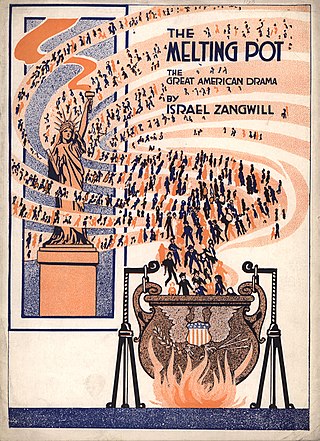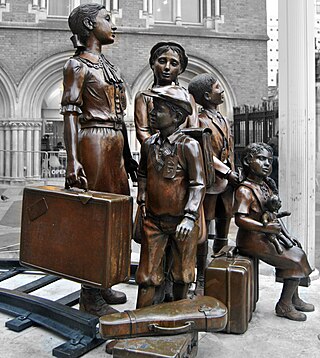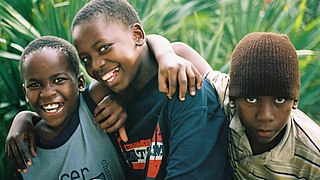
A melting pot is a monocultural metaphor for a heterogeneous society becoming more homogeneous, the different elements "melting together" with a common culture; an alternative being a homogeneous society becoming more heterogeneous through the influx of foreign elements with different cultural backgrounds, possessing the potential to create disharmony within the previous culture. It can also create a harmonious hybridized society known as cultural amalgamation. In the United States, the term is often used to describe the cultural integration of immigrants to the country. A related concept has been defined as "cultural additivity."

Human migration is the movement of people from one place to another with intentions of settling, permanently or temporarily, at a new location.
Cross-cultural communication is a field of study investigating how people from differing cultural backgrounds communicate, in similar and different ways among themselves, and how they endeavor to communicate across cultures. Intercultural communication is a related field of study.
Acculturation is a process of social, psychological, and cultural change that stems from the balancing of two cultures while adapting to the prevailing culture of the society. Acculturation is a process in which an individual adopts, acquires and adjusts to a new cultural environment as a result of being placed into a new culture, or when another culture is brought to someone. Individuals of a differing culture try to incorporate themselves into the new more prevalent culture by participating in aspects of the more prevalent culture, such as their traditions, but still hold onto their original cultural values and traditions. The effects of acculturation can be seen at multiple levels in both the devotee of the prevailing culture and those who are assimilating into the culture.
Cultural assimilation is the process in which a minority group or culture comes to resemble a society's majority group or assimilates the values, behaviors, and beliefs of another group whether fully or partially.

In sociology, an ethnic enclave is a geographic area with high ethnic concentration, characteristic cultural identity, and economic activity. The term is usually used to refer to either a residential area or a workspace with a high concentration of ethnic firms. Their success and growth depends on self-sufficiency, and is coupled with economic prosperity.
Intercultural communication is a discipline that studies communication across different cultures and social groups, or how culture affects communication. It describes the wide range of communication processes and problems that naturally appear within an organization or social context made up of individuals from different religious, social, ethnic, and educational backgrounds. In this sense, it seeks to understand how people from different countries and cultures act, communicate, and perceive the world around them. Intercultural communication focuses on the recognition and respect of those with cultural differences. The goal is mutual adaptation between two or more distinct cultures which leads to biculturalism/multiculturalism rather than complete assimilation. It promotes the development of cultural sensitivity and allows for empathic understanding across different cultures.
Transnationalism is a research field and social phenomenon grown out of the heightened interconnectivity between people and the receding economic and social significance of boundaries among nation states.

Immigration is the international movement of people to a destination country of which they are not usual residents or where they do not possess nationality in order to settle as permanent residents. Commuters, tourists, and other short-term stays in a destination country do not fall under the definition of immigration or migration; seasonal labour immigration is sometimes included, however.
Cultural competence, also known as intercultural competence, is a range of cognitive, affective, behavioural, and linguistic skills that lead to effective and appropriate communication with people of other cultures. Intercultural or cross-cultural education are terms used for the training to achieve cultural competence.
Migrant literature, sometimes written by migrants themselves, tells stories of immigration.

The sociology of immigration involves the sociological analysis of immigration, particularly with respect to race and ethnicity, social structure, and political policy. Important concepts include assimilation, enculturation, marginalization, multiculturalism, postcolonialism, transnationalism and social cohesion.
Integrative communication theory is a theory of cross-cultural adaptation proposed by Young Yun Kim. The first widely published version of Kim's theory is found in the last three chapters of a textbook authored by William Gudykunst with Young Yun Kim as second author. See acculturation and assimilation.
Cultural schema theory is a cognitive theory that explains how people organize and process information about events and objects in their cultural environment. According to the theory, individuals rely on schemas, or mental frameworks, to understand and make sense of the world around them. These schemas are shaped by culture, and they help people to quickly and efficiently process information that is consistent with their cultural background. Cultural schemas can include knowledge about social roles, customs, and beliefs, as well as expectations about how people will behave in certain situations. The theory posits that cultural schemas are formed through repeated interactions and experiences within a particular cultural group, and that they guide behavior in familiar social situations. Cultural schemas are distinct from other schemas in that they are shared among members of a particular cultural group, as opposed to being unique to individuals.

Cultural sensitivity, also referred to as cross-cultural sensitivity or cultural awareness, is the knowledge, awareness, and acceptance of other cultures and others' cultural identities. It is related to cultural competence, and is sometimes regarded as the precursor to the achievement of cultural competence, but is a more commonly used term. On the individual level, cultural sensitivity is a state of mind regarding interactions with those different from oneself. Cultural sensitivity enables travelers, workers, and others to successfully navigate interactions with a culture other than their own.
Co-cultural communication theory was built upon the frameworks of muted group theory and standpoint theory. The cornerstone of co-cultural communication theory is muted group theory as proposed in the mid 1970s by Shirley and Edwin Ardener. The Ardeners were cultural anthropologists who made the observation that most other cultural anthropologists practicing ethnography in the field were talking only to the leaders of the cultures, who were by and large adult males. The researchers would then use this data to represent the culture as a whole, leaving out the perspectives of women, children and other groups made voiceless by the cultural hierarchy. The Ardeners maintained that groups which function at the top of the society hierarchy determine to a great extent the dominant communication system of the entire society. Ardener's 1975 muted group theory also posited that dominant group members formulate a "communication system that support their perception of the world and conceptualized it as the appropriate language for the rest of society".
Second-generation immigrants in the United States are individuals born and raised in the United States who have at least one foreign-born parent. Although the term is an oxymoron which is often used ambiguously, this definition is cited by major research centers including the United States Census Bureau and the Pew Research Center.

Nearly half of all refugees are children, and almost one in three children living outside their country of birth is a refugee. These numbers encompass children whose refugee status has been formally confirmed, as well as children in refugee-like situations.
A type of study used in economics, sociology, political science, and psychology, an audit study is one in which trained employees of the researcher ("auditors") are matched on all characteristics except the one being tested for discrimination. These auditors then apply for a service, be it a job, financial advice regarding their stock portfolio, housing, or a credit card, to test for discrimination.

Ruud Koopmans is a Dutch sociologist and professor at the Humboldt University of Berlin. His research focuses on migration, social integration and transnationalization.









